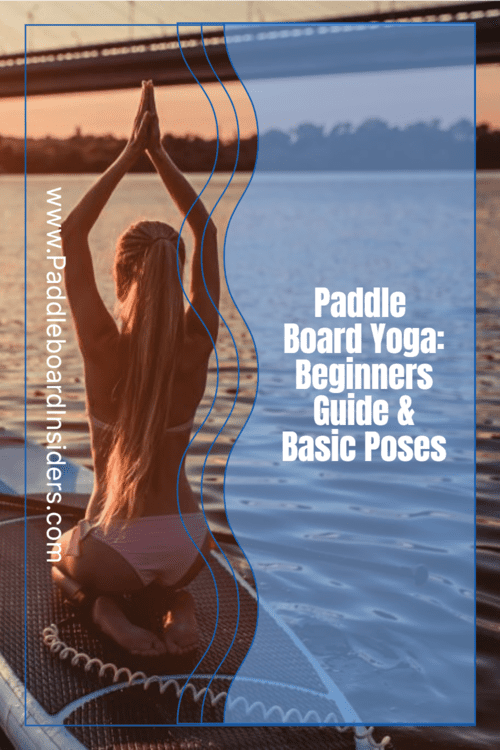Paddle Board Yoga: Beginners Guide & Poses
*We may earn a commission for purchases made using our links. Please see our disclosure to learn more.
Ever thought about trying something new and exciting that combines fitness, nature, and mindfulness? Paddle board yoga or SUP Yoga might just be your next adventure.
This unique form of yoga brings together the tranquillity of being on water with the physical challenge and benefits of a traditional yoga workout. 🧘♂️
Stick around to explore what it’s all about – we promise it’s more fun than walking plank!
| Looking for our best paddle board product recommendations? Check the Paddleboard Insiders Buyer Guides |
Table Of Contents
What is Stand Up Paddle Board (SUP) Yoga?
Stand Up Paddle Board (SUP) Yoga, also known as paddle board yoga, takes traditional yoga to the water. This unique form of fitness involves practicing yoga poses on a stand-up paddleboard rather than a mat.
The added challenge is balancing on the board while it floats in calm bodies of water like lakes, rivers or swimming pools.
The beauty of SUP Yoga lies not only in exercising your stabilizing muscles but also improving proprioception – your body’s awareness of its position and movement. It’s an exciting blend of focus, strength and balance where every stretch becomes an adventure.
From beginner-friendly moves such as Easy Pose and Child’s pose to more advanced stances like Warrior I or Full Wheel – there’s always room for growth and development in this fun outdoor activity!
Benefits of Paddle Board Yoga
Paddleboard yoga, fondly referred to as SUP yoga, offers diverse physical and mental benefits.
- SUP yoga enhances flexibility because each pose aims to stretch various muscle groups.
- This practice strengthens the body’s stabilizing muscles, enhancing balance and coordination skills.
- Practicing poses on an unstable surface like a paddle board acts as a great workout, engaging different muscles.
- One noticeable benefit of SUP yoga is the improvement in proprioception: your body’s awareness of position and movement in space.
- It challenges focus by demanding attention on maintaining balance while executing poses on water.
- The unique combination of nature and exercise contributes towards mind – body wellness, creating a serene environment for relaxation.
- For adventure seekers, it adds an exciting twist to regular yoga routines by introducing the elements of water and balancing.
- It is inclusive for all fitness levels since beginners can start with simple poses before progressing into more challenging ones.
Essential Gear for Paddle Board Yoga
Diving into paddle board yoga practice requires having the right equipment on hand. Here are some essential gear pieces you’ll need for SUP Yoga:
- A Stand-Up Paddle Board: The primary equipment for SUP yoga is, of course, a paddle board. Choose one that provides stability and balance while performing yoga poses.
- A Paddle: Besides helping you navigate in water, a paddle can also serve as an excellent tool for deepening your stretches in certain yoga poses.
- Personal Floatation Device (PFD): For safety measures, always keep a personal floatation device on your board during SUP yoga.
- Waterproof Case: It’s wise to invest in a waterproof case for storing valuable items like car keys or mobile phones, which could potentially fall into the water during your session.
- Appropriate Clothing: Dress according to the weather. Quick-dry clothing or swimwear is ideal.
- Sunscreen and Wide-Brim Hat: Protect yourself from harmful sun rays by wearing sunscreen and a wide-brim hat.
- An Anchor: To stop your paddle board from drifting away while practicing yoga, use an anchor. This allows more focus on maintaining balance instead of constantly adjusting your position in the water.
- Water Bottle: Stay hydrated throughout the session by keeping a water bottle handy.
Tips for Practicing SUP Yoga
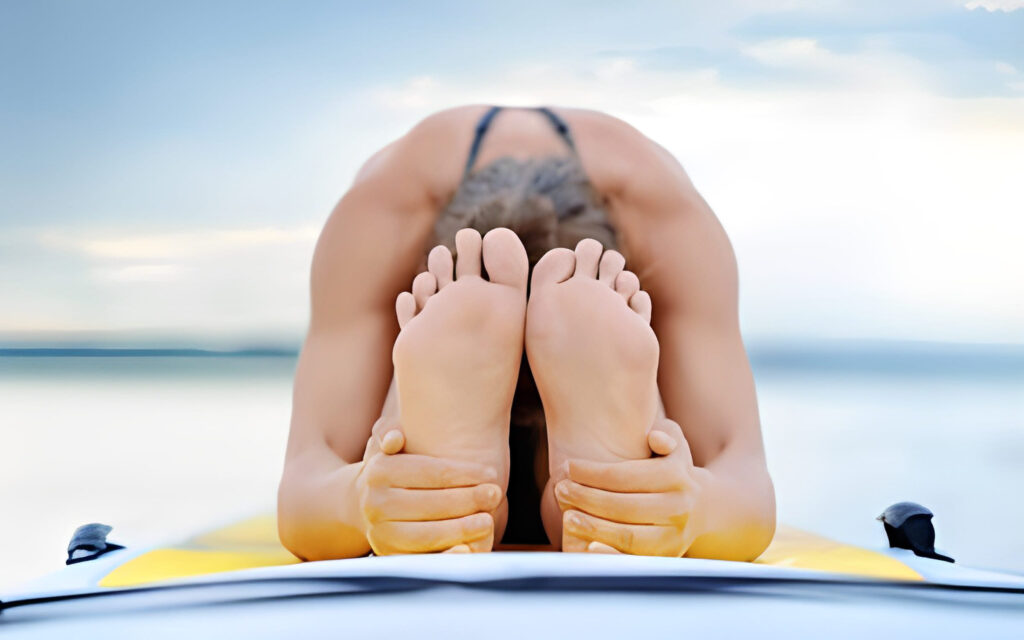
- Find a calm and stable body of water to practice on, such as a lake or river.
- Start with basic poses and gradually progress to more advanced ones as you gain confidence and stability on the paddleboard.
- Focus on your breath and maintain a steady rhythm throughout your practice to help center and calm your mind.
- Use a wide stance and engage your core muscles to improve balance and stability on the paddleboard.
- Don’t be afraid to fall! Embrace the challenge of practicing yoga on water and view falling as an opportunity to learn and grow.
Essential SUP Yoga Poses for Beginners
In this section, we will explore six essential SUP yoga poses for beginners that can help improve balance and build strength.
Easy Pose
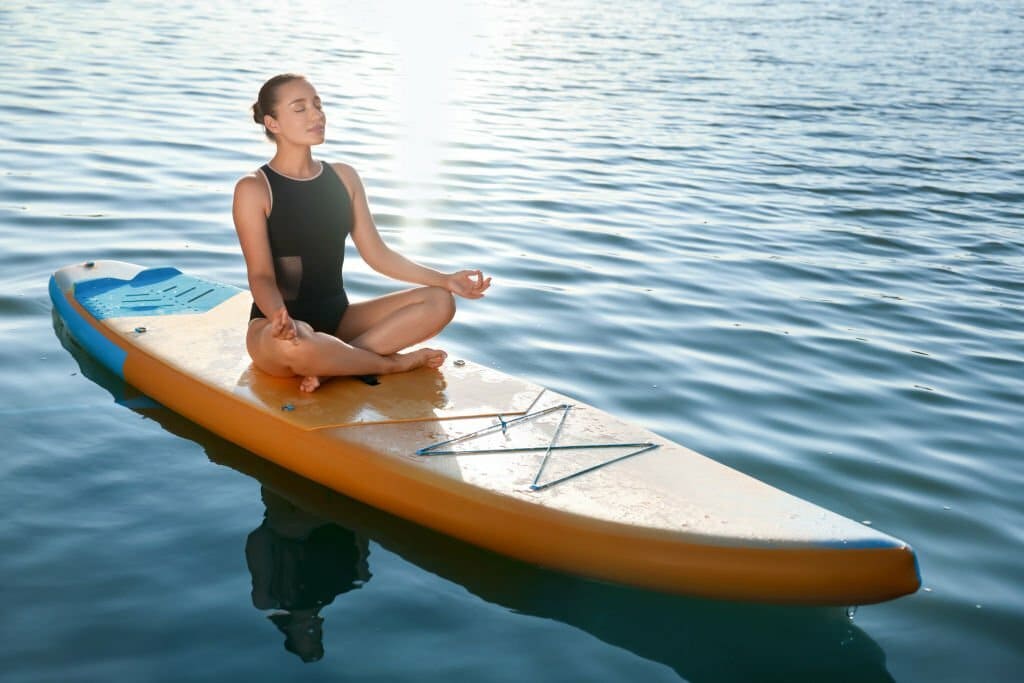
Easy Pose, also known as Sukhasana, is a foundational pose in yoga that is perfect for beginners practicing paddle board yoga. To do this pose, simply sit comfortably on your paddleboard with your legs crossed and your spine straight.
Place your hands on your knees or thighs, palms facing up or down. This seated position helps to improve posture and ease tension in the hips and lower back. Easy Pose also promotes relaxation and encourages a calm state of mind while enjoying the serenity of being out on the water.
Child’s Pose
Child’s Pose is a relaxing and restorative yoga pose that is often used as a resting position during a paddle board yoga session. To get into Child’s Pose, kneel on the paddleboard with your knees hip-width apart and sit back on your heels.
Lower your upper body forward, bringing your forehead to the board or placing it on top of stacked hands. This pose gently stretches the hips, thighs, and lower back, providing relief from tension and stress in these areas.

It also helps to calm the mind and deepen relaxation. Child’s Pose can be modified by widening the knees for more space or using props such as a bolster or blanket under the chest for support.
By practicing Child’s Pose during your paddle board yoga practice, you’ll give yourself moments of rest and relaxation while still enjoying the peacefulness of being out on the water.
It’s important to listen to your body while in this pose; if any discomfort arises in the knees or ankles, adjust accordingly to find a comfortable position. Take deep breaths and allow yourself to let go of any tension or distractions around you.
Downward-Facing Dog
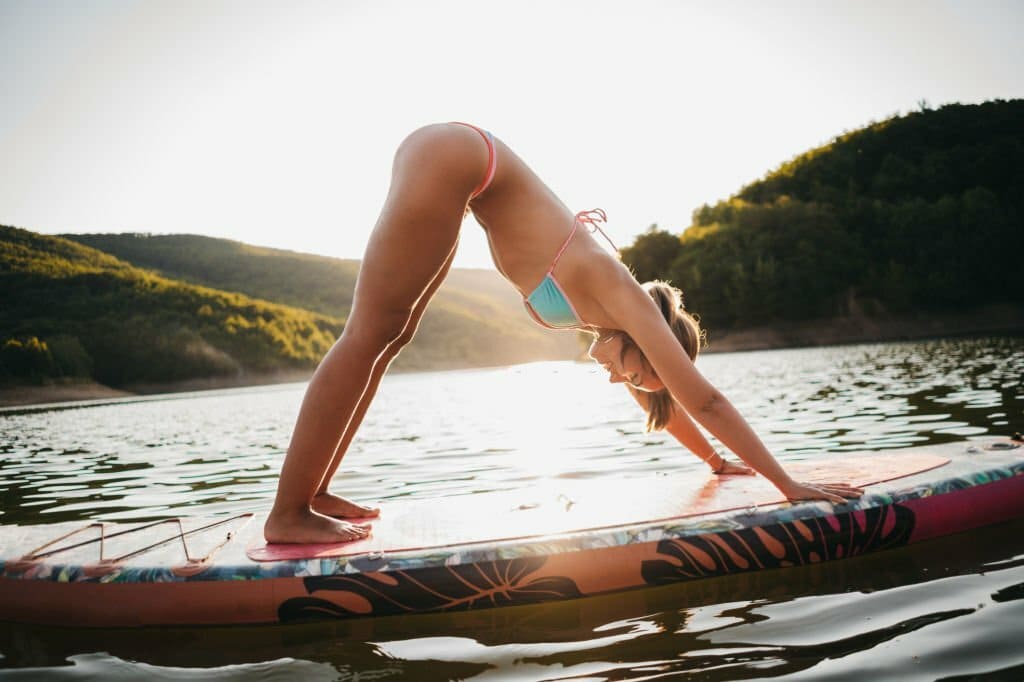
Downward-Facing Dog is a popular yoga pose that can be easily adapted for paddle board yoga. This pose helps to stretch and strengthen the upper body, including the arms, shoulders, and back.
To do this pose on a paddleboard, start in a tabletop position with your hands shoulder-width apart and your knees hip-width apart. Then, lift your hips up towards the sky while straightening your arms and legs.
Focus on pressing evenly through your hands and feet to create stability on the water. Take deep breaths as you relax into the pose and feel the gentle sway of the water beneath you.
Plank Pose
Plank pose is a foundational yoga pose that is commonly practiced on a paddleboard. It involves balancing in a push-up position, with the body in a straight line from head to toes.
This pose strengthens the core, arms, shoulders, and wrists while improving overall stability and balance. By engaging multiple muscle groups simultaneously, plank pose helps to increase strength and endurance.

On a paddleboard, this pose can be even more challenging as it requires additional focus and control to maintain balance on an unstable surface. Practicing plank pose regularly can enhance your overall paddle board yoga experience by building strength and stability throughout your entire body.
Cobra or Upward-Facing Dog
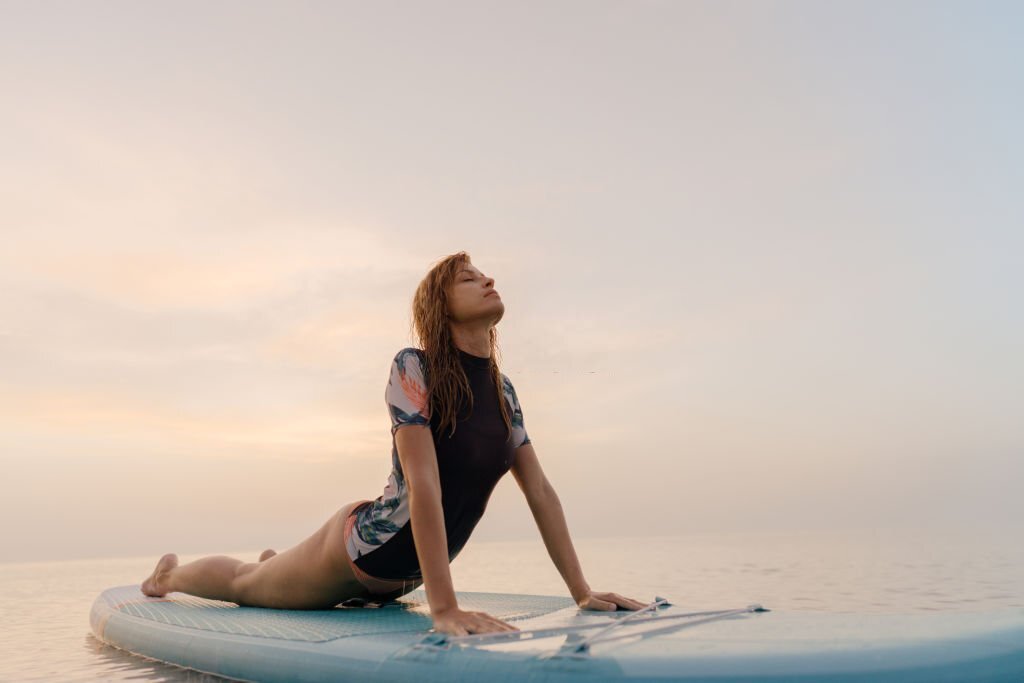
Cobra or Upward-Facing Dog is one of the essential SUP yoga poses for beginners. This pose not only strengthens and stretches the muscles in the back, but it also helps to improve posture and increase flexibility.
To perform this pose, lie facedown on your paddleboard with your legs extended behind you. Place your hands under your shoulders and press into them, lifting your chest off the board while keeping your hips grounded.
Lift through the crown of your head as you lengthen your spine and engage your core. Breathe deeply as you hold this pose for a few breaths before releasing back down to the board.
Low Lunge
Low Lunge is a beginner-friendly paddle board yoga pose that targets the hips, hamstrings, and quadriceps. To perform this pose, start in a standing position on your paddleboard with your feet hip-width apart.
Step one foot forward into a lunge position, making sure to keep your knee directly above your ankle. Lower your back knee down towards the board and sink deeper into the stretch. Keep your core engaged and reach both arms overhead for an added stretch.
This pose helps improve flexibility in the legs and opens up the hips, while also strengthening the lower body muscles.
Practicing Low Lunge on a paddleboard adds an extra challenge as you have to engage your stabilizing muscles to maintain balance on an unstable surface. It requires focus and concentration to find stability and alignment while enjoying the serenity of being surrounded by nature.
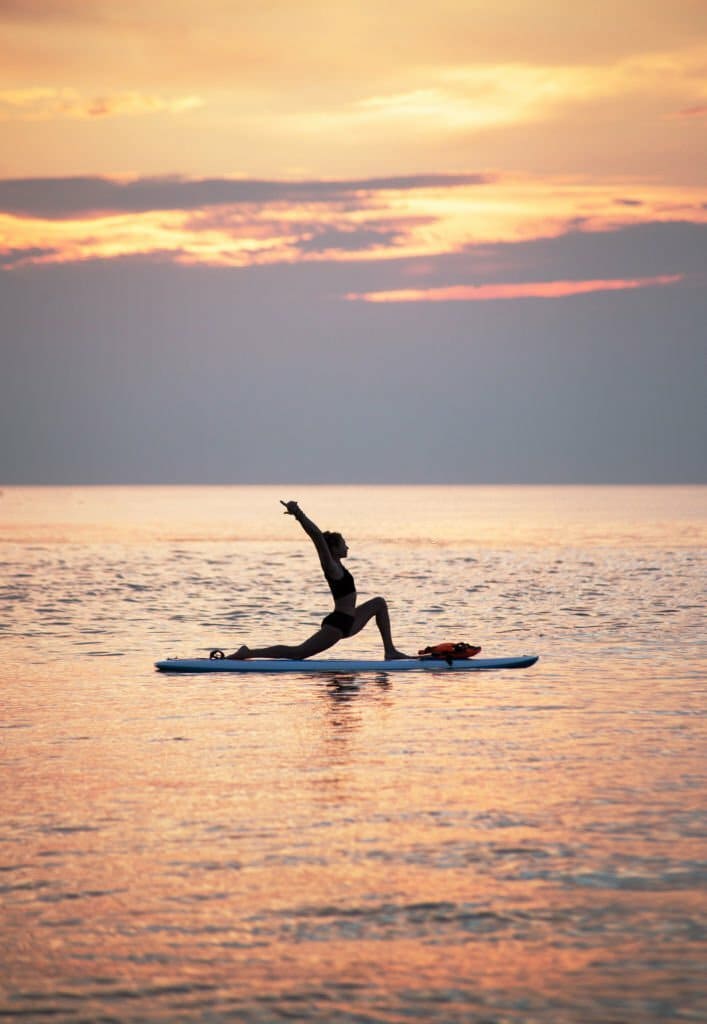
Bonus: Advanced SUP Yoga Poses
In this section, we will explore some challenging yoga poses that you can try once you have mastered the beginner’s poses. These advanced poses, such as the Full Wheel and Warrior 2, will push your balance and strength to new levels on your stand-up paddleboard.
Warrior 2
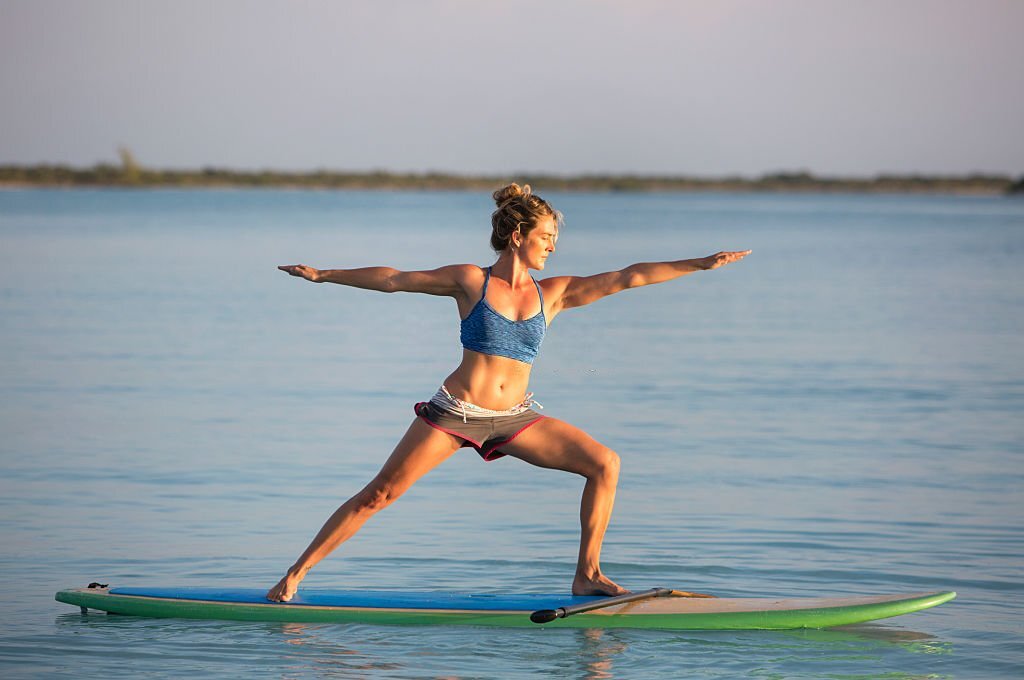
Warrior 2 is a powerful yoga pose that can be practiced on a paddleboard. To perform this pose, stand with your feet wide apart and extend your arms parallel to the ground, one in front of you and one behind you.
Keep your gaze focused forward and sink into a deep lunge, bending the front knee while keeping the back leg straight. Warrior 2 helps to strengthen the legs, hips, and core muscles.
It also improves balance and stability while promoting focus and mental clarity. This pose allows you to feel strong and grounded as you connect with nature on the water.
Full Wheel
Full Wheel is an advanced paddle board yoga pose that challenges both strength and flexibility. It involves lying on your back with your knees bent, feet hip-width apart, and hands planted firmly on the paddleboard beside your head.
With a push of the arms, you lift your entire body off the board into a deep backbend position. This pose stretches and strengthens the spine, shoulders, arms, and legs while improving core stability.
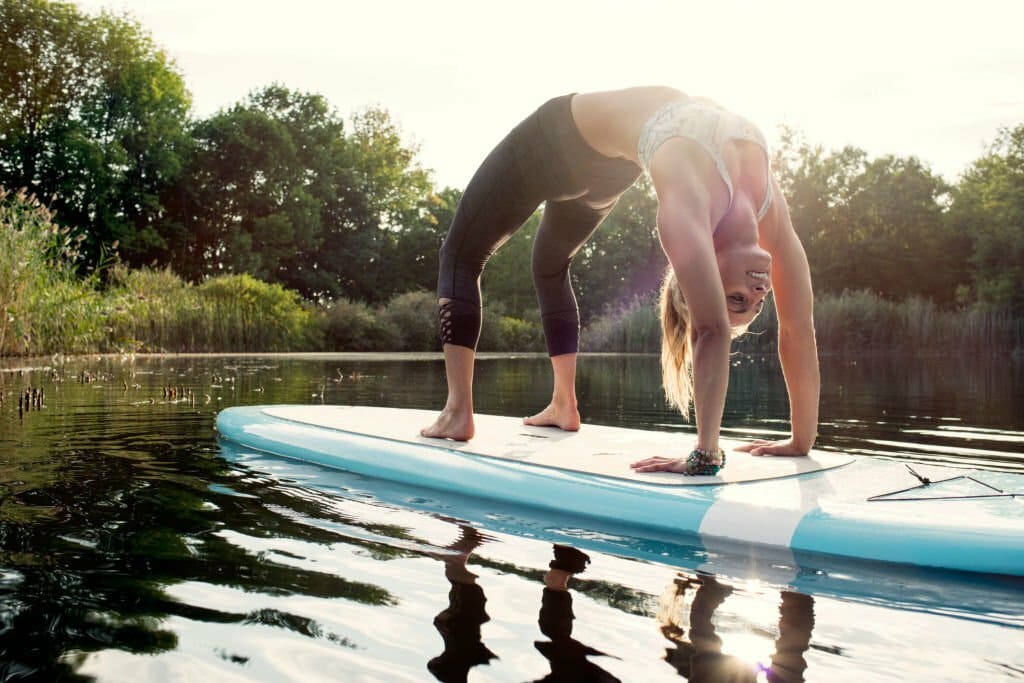
It requires focus and balance to maintain control on the unstable surface of the water. Full Wheel can be a beautiful expression of grace and strength when mastered by experienced practitioners.
Supported Headstand
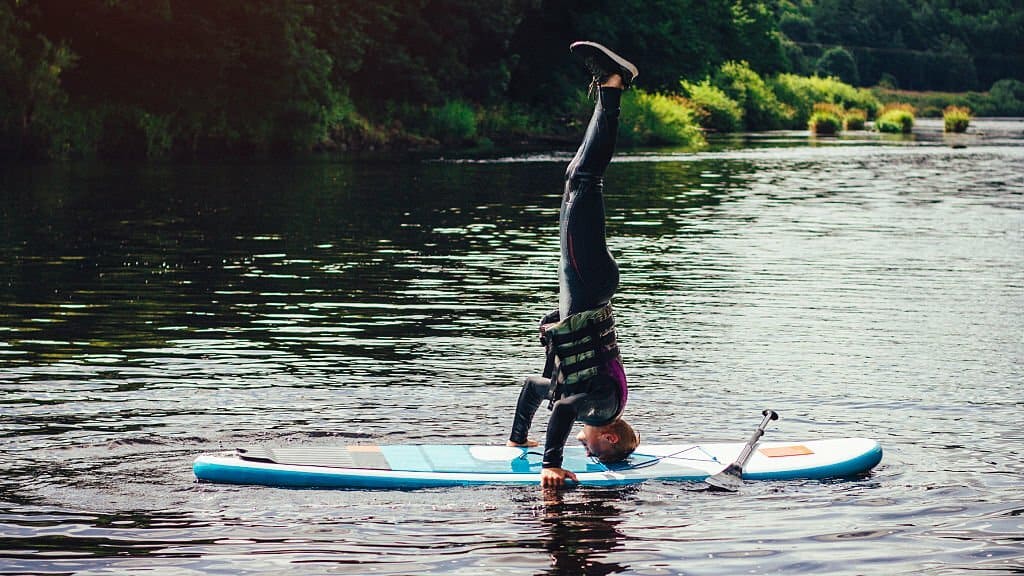
Supported Headstand is an invigorating yoga pose that can be practiced on a stand-up paddleboard. It involves balancing upside down with the support of your forearms and head, while keeping your core engaged and legs extended towards the sky.
This pose helps to build upper body strength, improve balance and focus, and increase blood flow to the brain. Practicing Supported Headstand on a paddleboard adds an extra element of challenge as you have to find stability on an unstable surface.
Remember to practice this advanced pose under the guidance of a certified SUP yoga instructor to ensure proper alignment and technique.
Modified Half Camel
Modified Half Camel is a popular yoga pose that can be adapted for practicing on a stand-up paddleboard. This pose helps to stretch the front of the body, including the chest, shoulders, and quadriceps.
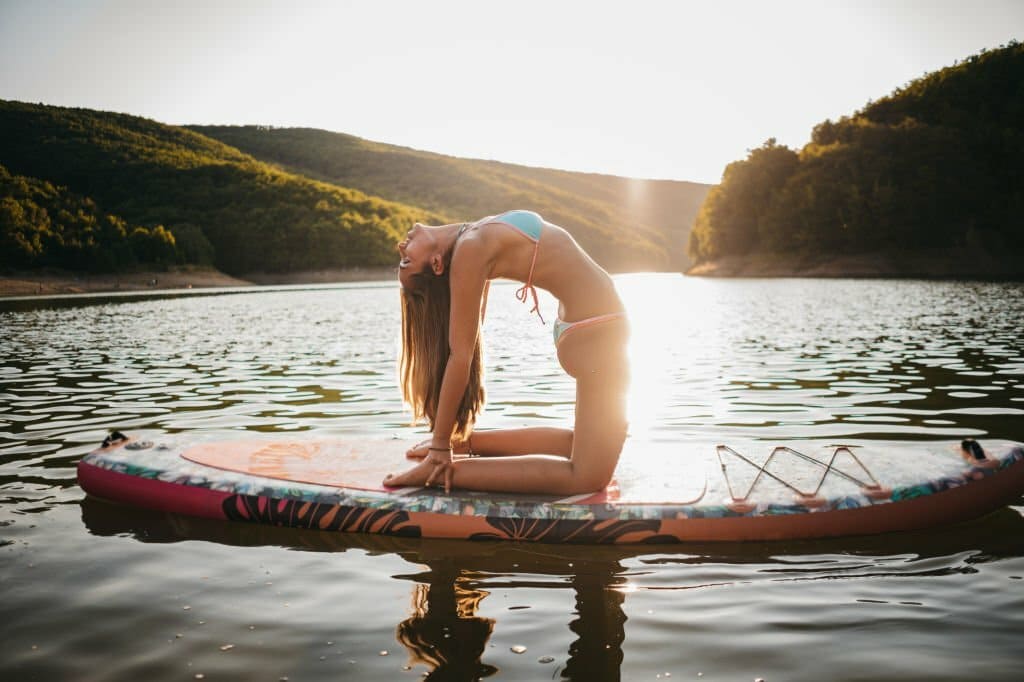
To perform Modified Half Camel, start by kneeling on your paddleboard with your knees hip-width apart. Extend one leg out to the side and rest the foot flat on the board. Inhale as you raise one arm overhead and exhale as you lean back slightly, placing your hand on your lower back or reaching for your heel if possible.
Hold this position for several breaths before switching sides. Modified Half Camel is a great way to increase flexibility in the upper body while also building strength in the core and legs.
Savasana
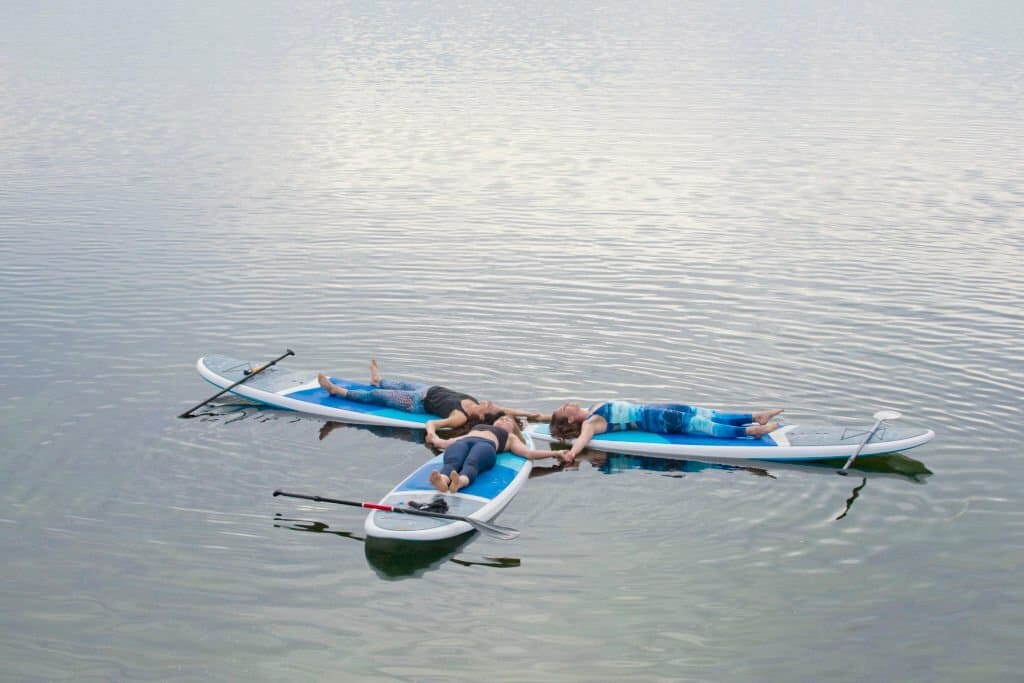
Savasana, also known as Corpse Pose, is a vital part of any yoga practice, including paddle board yoga. It is typically done at the end of a session to allow the body to relax and integrate the benefits of the previous poses.
In Savasana, you lie flat on your back with your arms and legs comfortably spread apart. This pose promotes deep relaxation and helps reduce stress and anxiety. During Savasana, it’s important to focus on your breath and let go of any tension or thoughts that arise.
By incorporating Savasana into your paddle board yoga routine, you can enhance your overall well-being and leave each session feeling rejuvenated and refreshed.
Sample Paddle Board Yoga Routine
Here is a really well done (and pintable) paddle board yoga routine that you can try out for your first time.

Image source: REI.com
Conclusion
In conclusion, paddle board yoga offers a unique and exciting way for beginners to experience the benefits of yoga while enjoying the serenity of the outdoors. By starting with simple poses and gradually progressing, beginners can develop strength, flexibility, and balance on the unstable surface of a stand-up paddleboard.
With proper guidance from certified instructors or classes, anyone can embark on this thrilling journey of paddle board yoga and reap its multitude of physical and mental rewards.
| Looking for insider guides to some amazing paddle boarding locations? Check the Paddleboard Insiders Location Guides |
Paddle Board Yoga FAQs
Is paddle board yoga suitable for beginners?
Yes, paddle board yoga can be enjoyed by beginners. However, it’s important to start with basic poses and take classes specifically designed for beginners to ensure safety and proper instruction.
What should I wear when practicing paddle board yoga?
It is recommended to wear comfortable athletic clothing that allows freedom of movement. Avoid wearing loose or baggy clothes that may get in the way during your practice.
How does practicing yoga on a paddle board benefit me?
Practicing yoga on a paddle board challenges your balance and stability, which helps improve core strength and overall body awareness. It also provides a serene and calming experience being surrounded by water in nature.
Do I need any previous paddling experience before trying paddle board yoga?
No, previous paddling experience is not necessary for trying paddle board yoga. However, it’s important to take beginner-friendly classes where instructors will teach you how to navigate the water safely, or learn the basic moves on how to stand.
Can anyone do paddle board yoga regardless of age or fitness level?
Paddle board yoga can be practiced by people of different ages and fitness levels as long as they feel comfortable being on a stand-up paddleboard in water. Modifications are available for various poses to accommodate different abilities and needs.
